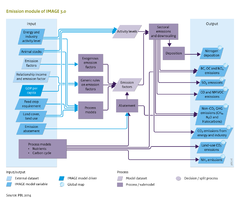Emissions/Description: Difference between revisions
Jump to navigation
Jump to search
No edit summary |
No edit summary |
||
| Line 2: | Line 2: | ||
|Reference=IPCC, 2006; Cofala et al., 2002; Stern, 2003; Smith et al., 2005; Van Ruijven et al., 2008; Carson, 2010; Smith et al., 2011; Bouwman et al., 1993; Velders et al., 2009; Kreileman and Bouwman, 1994; Bouwman et al., 1997; Bouwman et al., 2002a; | |Reference=IPCC, 2006; Cofala et al., 2002; Stern, 2003; Smith et al., 2005; Van Ruijven et al., 2008; Carson, 2010; Smith et al., 2011; Bouwman et al., 1993; Velders et al., 2009; Kreileman and Bouwman, 1994; Bouwman et al., 1997; Bouwman et al., 2002a; | ||
|Description===General approaches== | |Description===General approaches== | ||
[[ | The table on [[Emissions/Introduction#Inputs|the introduction page]] lists the different sources of emissions included in the IMAGE model. Emissions that are transported in water (nitrate, phosphorus) are discussed in [[Nutrient balances]]. Regarding the approach and spatial detail for modeling gaseous emissions, IMAGE uses four different ways to represent emissions. | ||
* ''World number'' (WRLD). The simplest way to estimate emissions in IMAGE is by using a global estimate from the literature. This approach is used for those natural sources that can not be explicitly modelled. | * ''World number'' (WRLD). The simplest way to estimate emissions in IMAGE is by using a global estimate from the literature. This approach is used for those natural sources that can not be explicitly modelled. | ||
* ''Emission factor method'' (EF). For other sources in IMAGE, past and future developments in anthropogenic emissions are estimated on the basis of projected changes in relevant economic activities and the emissions per unit of activity (emission factor) ( | * ''Emission factor method'' (EF). For other sources in IMAGE, past and future developments in anthropogenic emissions are estimated on the basis of projected changes in relevant economic activities and the emissions per unit of activity (emission factor) (see flowchart on the right). | ||
The equation for this emission factor approach is as follows: | The equation for this emission factor approach is as follows: | ||
| Line 15: | Line 15: | ||
* ''Emission factor method with spatial distribution'' (GEF) represents a special case of the EF method where a proxy distribution is used to present gridded emissions. This is done for a number of sources, for example emissions from animals ([[Table 5.1]]). | * ''Emission factor method with spatial distribution'' (GEF) represents a special case of the EF method where a proxy distribution is used to present gridded emissions. This is done for a number of sources, for example emissions from animals ([[Table 5.1]]). | ||
* ''Process model''. (GPM). Land-use related emissions of NH3, N2O and NO are calculated with grid-specific models. The models included in IMAGE are simple regression models that generate an emission factor ( | * ''Process model''. (GPM). Land-use related emissions of NH3, N2O and NO are calculated with grid-specific models. The models included in IMAGE are simple regression models that generate an emission factor (see flowchart on the right). It should be noted that for comparison with other models, IMAGE also includes the N2O methodology as proposed by [[IPCC]] ([[IPCC, 2006]]). | ||
The approaches used for emissions from energy production and use, industrial processes and land-use related sources are discussed in more detail below. | The approaches used for emissions from energy production and use, industrial processes and land-use related sources are discussed in more detail below. | ||
| Line 59: | Line 59: | ||
==Emission abatement== | ==Emission abatement== | ||
Future emissions for a number of energy and land-use related sources also vary in future years as a result of climate policy. This is described by using so-called abatement coefficients ( | Future emissions for a number of energy and land-use related sources also vary in future years as a result of climate policy. This is described by using so-called abatement coefficients (see flowchart on the right). The values of these coefficients depend on the scenario assumptions. In scenarios in which climate change or sustainability is an important feature in the storyline, abatement will be more important than in business-as-usual scenarios. Abatement factors are used in particular for CH4 emissions from fossil fuel production and transport, N2O emissions from transport and for CH4 emissions from enteric fermentation and from animal waste, and N2O emissions from animal waste according to the IPCC method. These abatement files are calculated in the climate policy submodel of IMAGE on the basis of comparing the costs of non-CO2 abatement in agriculture against other mitigation options. | ||
}} | }} | ||
Revision as of 15:23, 15 January 2014
Parts of Emissions/Description
| Component is implemented in: |
Components:and
|
| Projects/Applications |
| Models/Databases |
| Key publications |
| References |
|
